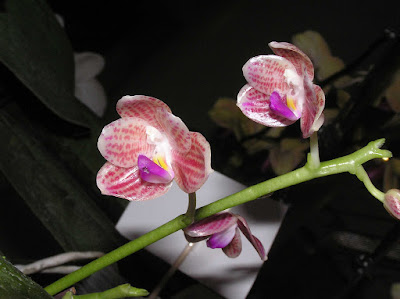The Javanese Phalaenopsis is native to South coast of Java, between Garut (Garoet) at an altitude of 700 m and the Gulf of Pelabuhan (Wijnkoops-Baai) at sea level. The amount of natural habitats is not reported, but it is known that it is grown in the Bogor Botanical Garden, at an altitude of 175 m.
Phalaenopsis javanica orchid, also called as The Javanese Phalaenopsis, Phalaenopsis javanica f. alba, Phalaenopsis latisepala, Polychilos javanica, is a species of the genus Phalaenopsis. This species was described by Johannes Jacobus Smith in 1918.
IDENTIFY PHALAENOPSIS JAVANICA ORCHID
The Javanese Phalaenopsis is native to South coast of Java, between Garut (Garoet) at an altitude of 700 m and the Gulf of Pelabuhan (Wijnkoops-Baai) at sea level. The amount of natural habitats is not reported, but it is known that it is grown in the Bogor Botanical Garden, at an altitude of 175 m.
It is a warm growing epiphyte with many glossy, elliptic-obovate leaves tapering to the base and apically acute or obtuse. The shiny, fleshy leaves are 23 cm long.
Phalaenopsis javanica blooms in the spring on a suberect, racemose, sometimes branching, to 10" (25 cm) long, rhachis fractiflex, few flowered inflorescence with triangular, acute-acuminate, concave floral bracts with fleshy, cupped flowers. The flowers are 2.5 cm in diameter, they smell of violets, they are fleshy, the flower has a bit bucket shape. The overlapping petals of both whorls are white, greenish-yellow or yellow and marked with vertical stripes, which in fact consist of small dots. The lip is purple, yellow and white.
GROW AND CARE PHALAENOPSIS JAVANICA ORCHID
Cultural information should only be used as a guide, and should be to be adapted to suit you. Your physical location; where you grow your plants, how much time you have to devote to their care, and many other factors, will need to be taken into account. Only then can you decide on the cultural methods that best suit you and your plants.
Light:
The Javanese Phalaenopsis needs a light level of 10,000-12,000 lux and keep in partial shade.
Temperature:
The average temperature of the day is 29-31 ° C and during the year it changes only by 2 ° C. The average night temperature is 23-24 ° C and changes even less during the year. The summer daily difference is 6-7 ° C. However, this species also grows at higher heights, so the average temperatures can be gradually reduced by up to 3 ° C if the plant does not react well to the given temperatures.
Humidity:
The plant needs the humidity of 80% during the growing season.
Substrate, growing media and repotting:
The substrate must be a mixture of 12-16 mm bark. Small pieces of limestone can be added to the substrate. Limestone is beneficial for the plant provided it is used for watering at 21 ° C.
Repotting can be performed after flowering or when new roots are actively growing.
Watering:
Plants should be constantly moist throughout the year. It is suggested to water it with warm water at a temperature of about 21 ° C. The precipitation pattern is wet / dry, but the dry season is relatively short.
Fertilizer:
It is recommended that 1/4-1/2 doses of fertilizer for orchids applied every week or every 2 weeks in the growing season.
Rest period:
Despite uniform temperatures, plants need 2-3 months of rest. Humidity should be reduced to 60-65%, the amount of water only for light spraying every few days, and fertilization should be limited to monthly. You can slightly increase the light level for 1-2 months.















COMMENTS